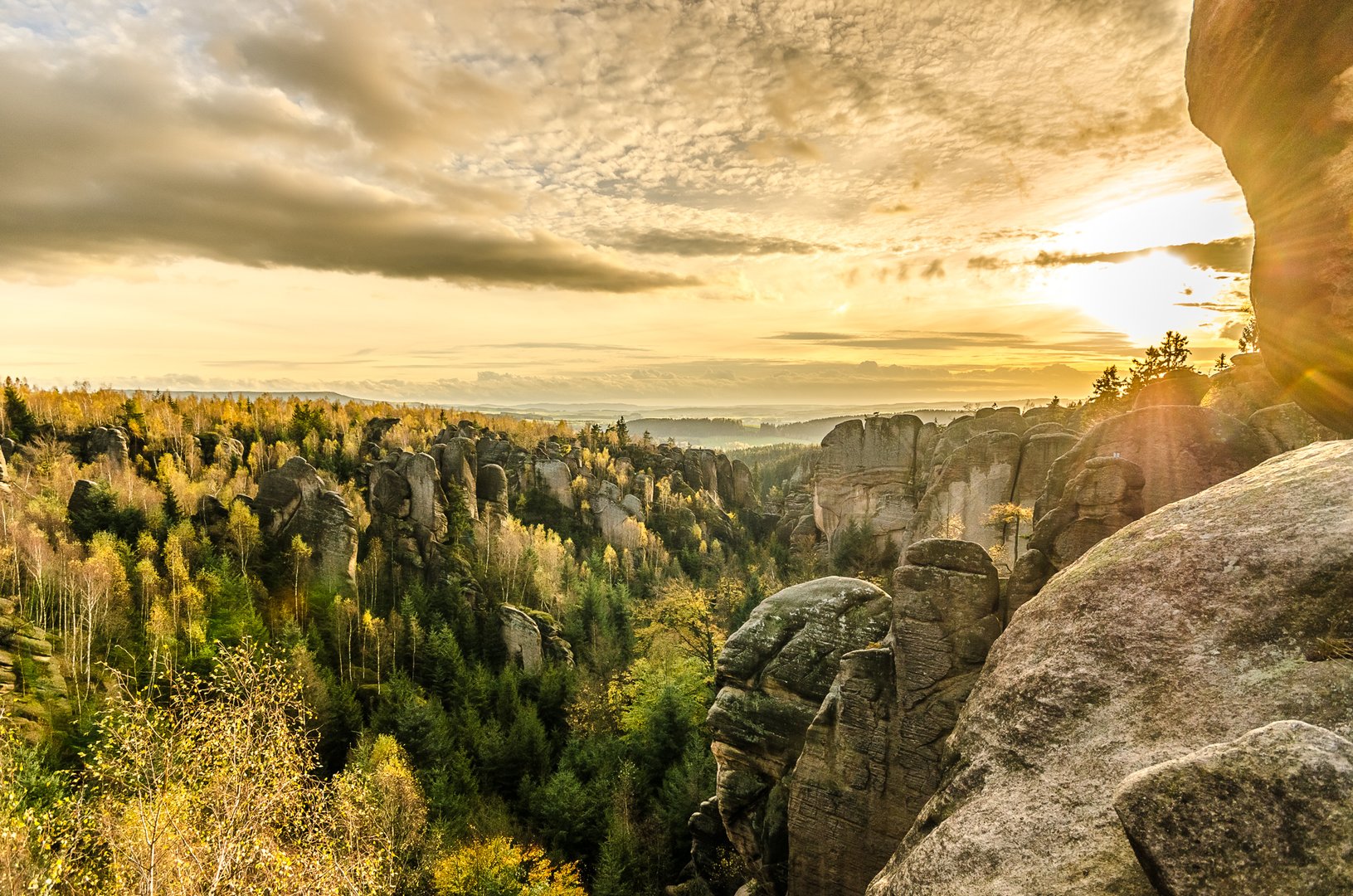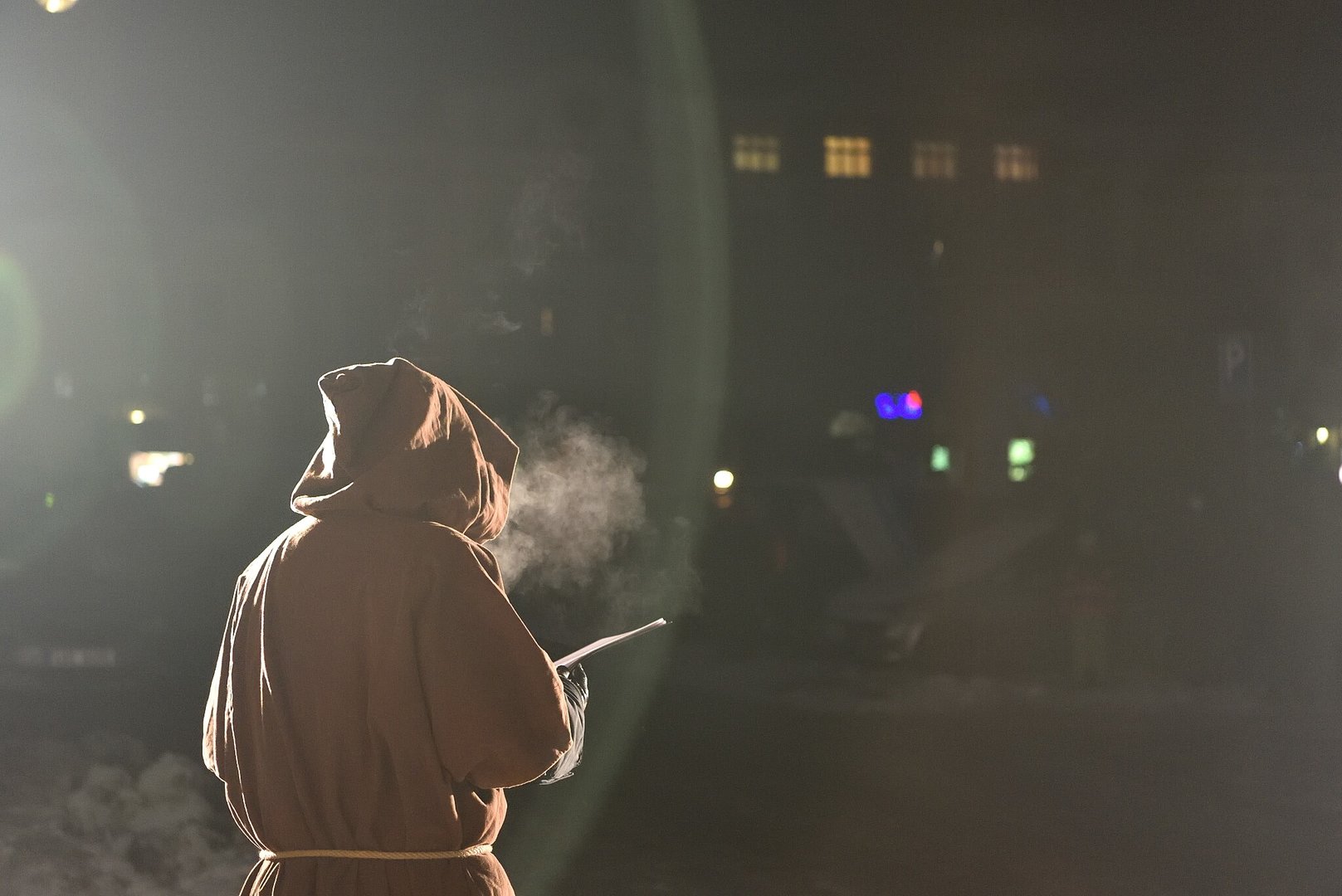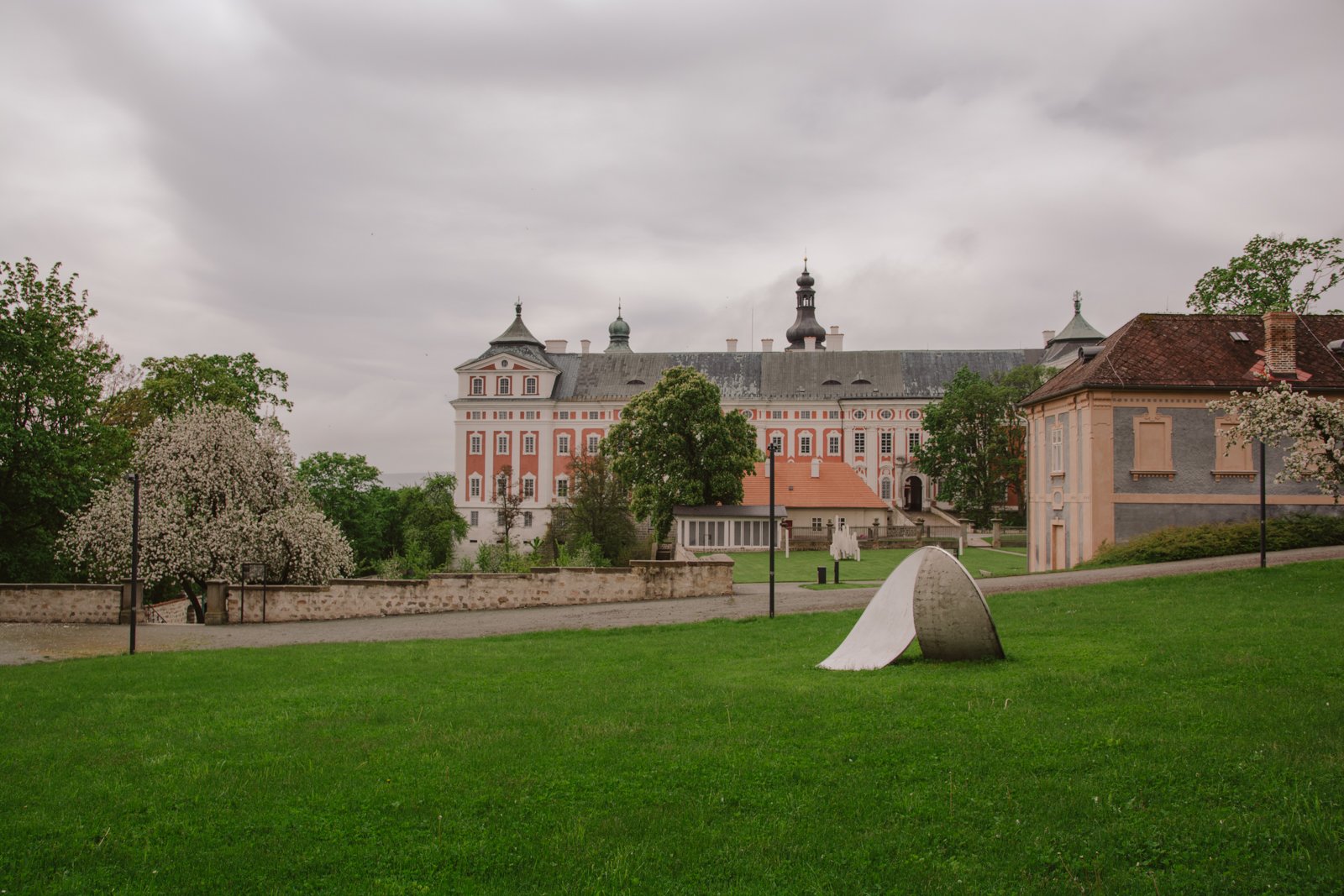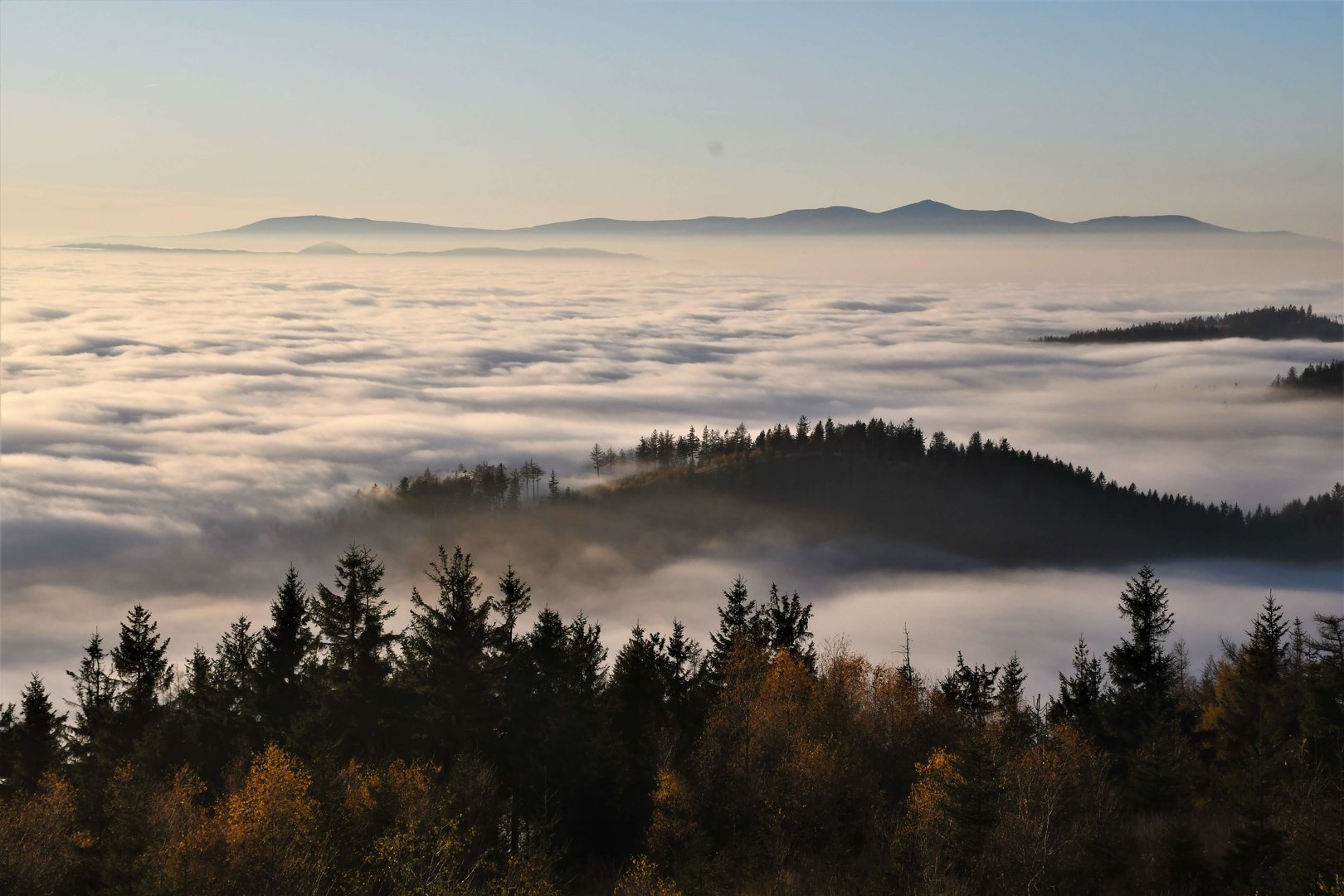BROUMOV AND ITS REGION
INTRODUCTION
Broumovsko (Broumov region) is a small region surrounded by hills, forests and rocks in the northeast of the Czech Republic on the border with Poland. It is almost fully overlapping the area of the Broumovsko Protected Landscape Area which defines not only its size, but also the overall character. Broumovské stěny and sandstone rocks are natural landmarks of the landscape and the intersections of the influences of economic and cultural centres of the region - Broumov, Police nad Metují and Teplice nad Metují.
The area is separated from the rest of the country by a wall of sandstone rocks. Far from the centre of the country, it was always a bit closed off and lived on its own. This is the basis of its genius loci influenced by history, the Benedictines and a significant, almost complete, exchange of inhabitants after 1945. Broumovsko has always been considered a peculiar territory, it was a meeting place of cultures, nationalities and worldviews - and much of it remains to this day. The town of Broumov is the heart of the region. The town with less than 7,400 inhabitants has always served its surroundings as a cultural, educational and economic centre. Despite its remoteness and history, Broumov region is catching its second wind so that it can once again become a culturally rich centre where opposites meet.
Rock town, photo by Jaroslav Winter / Baroque chapel on Hvězda, photo by Tomáš Šrejber


HISTORY
An important moment in the history of Broumovsko was the arrival of the Benedictine order. They brought German colonists there, who they always supported both spiritually and materially. During the times when the Benedictines were present in the area, the region saw a great development in education and culture from the very beginning, as well as economic prosperity. The first great prosperity of the area occurred in the first half of the 15th century, when Broumov served as a replacement headquarters for the Břevnov Benedictines, who fled there after the burning of the Břevnov monastery by the Hussites. They also brought with them several valuable items, including Codex gigas, which was later taken to Sweden as spoils of war. The second great flourishing occurred in the second half of the 16th and first half of the 17th century under the abbots Thomas Sartor and Otmar Zinke. They expanded the monastery's collection of works of art and enabled the reconstruction of the monastery and the construction of Baroque churches in the surrounding villages. Architects Kilian Ignaz and Christoph Dientzenhofer designed the so-called Broumov group of churches and the reconstruction of the monastery. The Benedictines were present in the Broumov region until the end of World War II. After that, the German members of the order were expelled from Broumov and settled in Rohr, Bavaria. Since 1950, the monastery served as an internment camp, first for monks and then for nuns of various orders. The Benedictines never returned to the monastery in Broumov.
 In addition to the Benedictines, a large community of broadcloth makers also took part in shaping the town and its surroundings, they established a tradition of textile production that continues to this day. A major turning point occurred in the 19th century. The abolition of serfdom, the construction of a railway line between Choceň and Broumov and the overall industrialization of the town and surrounding villages brought rapid development of the area. Schools, factories and tenement houses were built throughout the region. Josef Schroll was one of the significant drivers of this development. His company with two thousand employees was the third largest weaving mill in the Austrian-Hungarian Empire, and today we would see him as a socially responsible entrepreneur. He built hospitals, canteens, flats and houses, and libraries for his employees.
In addition to the Benedictines, a large community of broadcloth makers also took part in shaping the town and its surroundings, they established a tradition of textile production that continues to this day. A major turning point occurred in the 19th century. The abolition of serfdom, the construction of a railway line between Choceň and Broumov and the overall industrialization of the town and surrounding villages brought rapid development of the area. Schools, factories and tenement houses were built throughout the region. Josef Schroll was one of the significant drivers of this development. His company with two thousand employees was the third largest weaving mill in the Austrian-Hungarian Empire, and today we would see him as a socially responsible entrepreneur. He built hospitals, canteens, flats and houses, and libraries for his employees.
Industry has become an indispensable part of the Broumov region not only in terms of economic prosperity, but also its visual appearance. Since then, the Broumov region has inseparably included small factories, their chimneys and also the magnificent villas of the then owners. With the development of the town, Broumov's cultural and social life also flourished. The industry remained in the region until the end of World War II, when all companies were subsequently nationalized. Despite of some companies being shut down, textile and industrial production is important for the region up to now.
Three wise men, photo: archive of IC Broumov
CULTURE, MONASTERY AND THE CANDIDACY
Culture is an indispensable part of the Broumov region. Following the Benedictine legacy, the history of the area and the revitalization of the monastery, the candidacy for the European Capital of Culture is a natural step in its further development - A step that can help strengthen the role of the town as a cultural and educational centre important for the immediate area as well as the whole country and abroad. The diversity of cultural life in Broumov is not only based on institutions, but on engaged citizens, individuals as well as groups. Thanks to them, a wide range of cultural programmes is created, where everyone can find something for themselves. In the cultural overview you can find events organized by the Municipality of Broumov, the Educational and Cultural Centre Broumov, Ulita Youth Club, Broumov Art School and local schools, associations and individuals. It is the culture events organized by the people themselves that is an indispensable part of the colour palette of Broumov culture.
In the past, Broumov Monastery was an important place in the town as a centre of culture and education. The monastery grammar school founded in 1624, where the Benedictines passed on their knowledge, is the third oldest in the Czech Republic. Its graduates include, for example, Arnošt of Pardubice, Alois Jirásek and Bohuslav Balbín. Today, the Broumov Grammar School continues its tradition.
 During communism, the monastery could not serve its main purpose – to be a centre of culture and education for its wider area. However, it has been living again for more than a decade. An important point that allowed using the monastery again, was its revitalization. This was initiated by Agentura pro rozvoj Broumovska (Broumovsko Development Agency), which rents part of the monastery from the Benedictine order. Much of the ongoing revitalization took place in 2014 and 2015 and included not only the repair of damaged parts of the monastery, but also the restoration of frescoes and furniture in the monastery library or the construction of facilities for educational and cultural events. Former Benedictine cells have been converted into tourist accommodation. The restoration also included the monastery garden and all its buildings.
During communism, the monastery could not serve its main purpose – to be a centre of culture and education for its wider area. However, it has been living again for more than a decade. An important point that allowed using the monastery again, was its revitalization. This was initiated by Agentura pro rozvoj Broumovska (Broumovsko Development Agency), which rents part of the monastery from the Benedictine order. Much of the ongoing revitalization took place in 2014 and 2015 and included not only the repair of damaged parts of the monastery, but also the restoration of frescoes and furniture in the monastery library or the construction of facilities for educational and cultural events. Former Benedictine cells have been converted into tourist accommodation. The restoration also included the monastery garden and all its buildings.
Broumov monastery, photo by Jitka Smolíková
LANDSCAPE
Large forests, hills, meadows, sandstone rocks. Lots of places to hide, to be alone. To hear the silence that the Benedictines fell in love with many centuries ago. Places where you can see the landscape and contemplate. Life, the universe, the future, yourselves.
.jpg) Nature is an indispensable essence of the local genius loci. The essence of the Broumovsko Protected Landscape Area are large sandstone rock towns, protected plants, animals and habitats. The Baroque landscape brings a unique combination of folk architecture, urbanism and sensitive nature management. The landscape of two rock towns, the Broumov Walls and the Teplice-Adršpach Rocks, the latter being the largest rock town in the Czech Republic, is completed by sacral buildings. The character of the local villages is enhanced by their arrangement and unique classicist farm estates.
Nature is an indispensable essence of the local genius loci. The essence of the Broumovsko Protected Landscape Area are large sandstone rock towns, protected plants, animals and habitats. The Baroque landscape brings a unique combination of folk architecture, urbanism and sensitive nature management. The landscape of two rock towns, the Broumov Walls and the Teplice-Adršpach Rocks, the latter being the largest rock town in the Czech Republic, is completed by sacral buildings. The character of the local villages is enhanced by their arrangement and unique classicist farm estates.
However, this landscape is also important for reasons that you may not notice at first glance. The region can be described as a kind of "European roof ", because drainage areas of two seas meet on the top of the Broumov Walls. Extensive rock plateaus, gorges, and labyrinths were created by the sedimentation of sands and the retreat of the prehistoric sea. Thanks to the geological structure and this dynamic development, the area is one of the important reservoirs of drinking water.
Organizations such as Živá voda (Living Water), Living Landscape Model, which represents a comprehensive approach to climate change adaptation, or the Maiwald Academy, are working with other active individuals and their families to return water to the landscape. They revitalize streams and floodplains, create ponds and wetlands and are dedicated to environmental education. The sought-after tourist destination thus also brings inspiration and hope in access to strategic resources.
Stone gate in the Broumov Walls, photo by Jan Řeháček
Ticháček’s chapel, photo by Tomáš Šrejber / Maple mountains, photo by Stanislav Stařík

.jpg)

